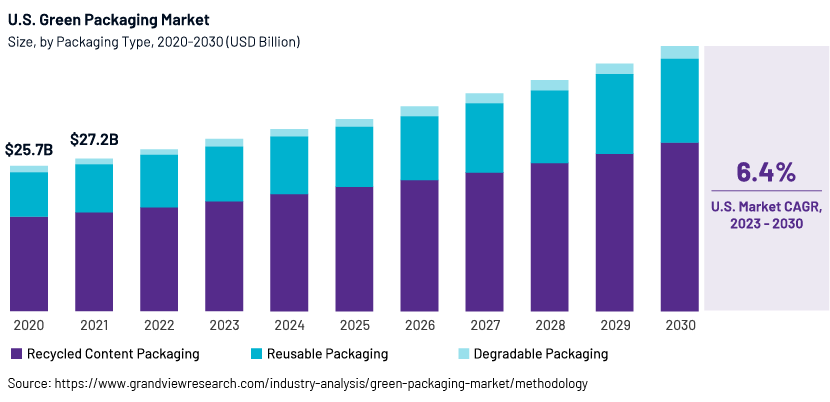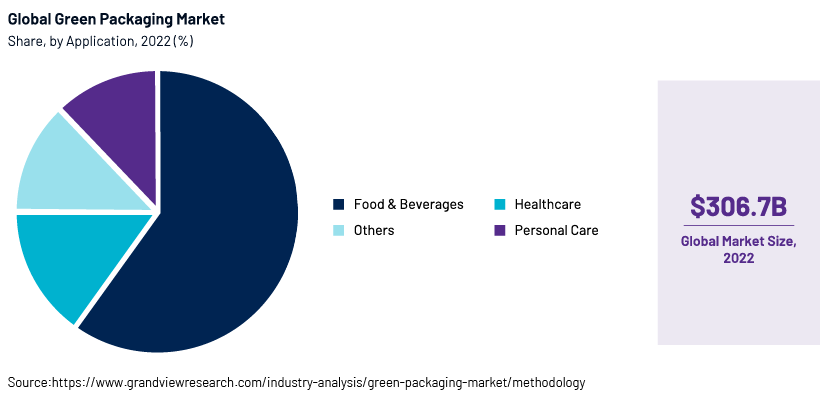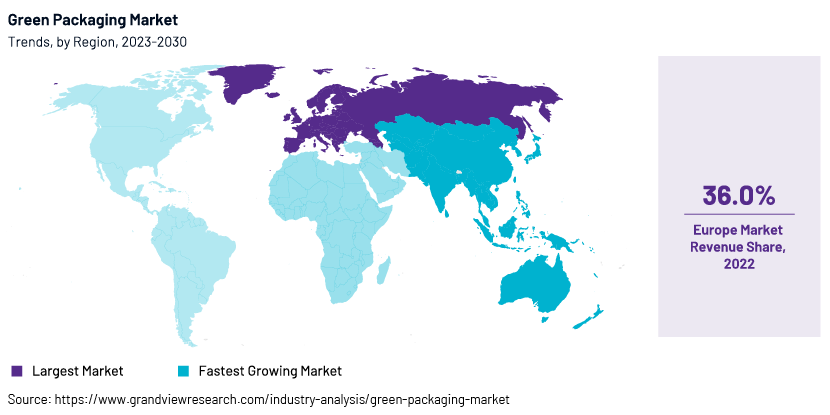Published on August 31, 2023 by Rupal Pujara
Sustainable materials are not always eco-friendly, but it has become necessary to adopt sustainable packaging if we are to avoid excessive waste and greenhouse gas emissions.
Companies such as Amazon, USPS, FedEx and UPS ship millions of packages every day. Amazon alone ships over 13m1 packages daily and 5bn[1] Prime packages annually. The world also ships much more industrial cargo.
Cardboard boxes have a lower ecological impact than alternatives such as like plastic and Styrofoam packing that is not degradable and cannot be recycled.
The Environmental Protection Agency (EPA) estimates that packaging generates an astounding 77.9 tons of municipal solid garbage annually, or over 30%1 of all waste and 65% of all household trash.
Facts about packaging:
-
The high cost of goods is partly due to packaging. USD1 of every USD10 spent on producing goods is spent on packaging, i.e. 10%1 of consumer spending is allocated to packaging that will eventually be discarded
-
It costs approximately USD30 per tonne1 to recycle waste, USD50 per tonne1 to transport waste to a landfill and USD65-751 to burn waste, which also emits hazardous gases
Forty-two percent1 of the respondents in a recent survey conducted by GlobalWebIndex said packaging made of recycled or sustainable materials was essential to their regular purchasing practices. Fifty-seven percent1 said they would be prepared to pay more for packaging that is environmentally friendly.
Seventy-five percent1 of millennial participants consider sustainability before making a purchase, according to a survey conducted by McKinsey and Company. There is higher demand for eco-friendly packaging options that reduce carbon emissions and minimise waste. As consumers choose sustainable packaging due to their awareness of climate change, it is important that businesses reduce their carbon footprint and not resort to greenwashing.
The definition of sustainable packaging now goes beyond its ability to be recycled. It also encompasses reducing the environmental impact throughout a product's lifecycle. This includes collecting the materials required, producing and transporting the packaging, using them only when they arrive at their destination and removing or recycling them.
The global green packaging market was estimated at USD306.73bn2 in 2022 and is expected to grow at a CAGR of 6.5% from 2023 to 2030, according to Grand View Research. This is linked to growing consumer knowledge of sustainable packaging options and strict government laws, such as the prohibition of single-use plastic packaging items. Green packaging solutions are made of sustainable materials including paper, plant-based materials, recycled materials, and other biodegradable materials that have a smaller carbon footprint – from production to disposal.

What is green packaging material?
"Green packaging", also known as "sustainable packaging", refers to products and production methods that use less energy and fewer packaging materials that have a negative impact on the environment. Biodegradable and recyclable materials such as cellulose packaging and recycled cardboard are frequently used in green packaging solutions, and environmentally friendly manufacturing techniques are applied to reduce their energy consumption and greenhouse gas emissions.
Green packaging options can also be classified based on the materials used and how they are disposed of.
-
Recyclable packaging:This is made from materials that can be recycled at traditional facilities. Recyclable refers to what can be done with the packaging after its useful life is over.
-
Post-consumer recycled packaging (PCR):This refers to new packaging made from materials that have already been disposed of and recycled.
-
Biodegradable packaging: These materials are often made from plant-based or bio-plastic materials. Such packaging may have microorganisms that help break down the materials.
-
Compostable packaging :Packaging that is made from natural plant materials and can return to the earth naturally and help the planet’s systems regrow.
Understanding the types of green packaging
The market for green packaging is divided into three categories based on the type of packaging:
-
Recycled packaging: In 2022, packaging made with recycled content dominated, with a market share of over 60.0%.[3] Packaging with recycled content is further divided into paper, plastic, glass, metal and other categories. Due to their affordability versus other recycled materials’, recycled plastics such as polyethylene terephthalate (PET) and high-density polyethylene (HDPE) are the most popular choices for products such as pouches, bottles and containers. In terms of type of packaging with recycled material, the paper subsegment is expected to grow rapidly from 2023 to 2030. This development can be attributed to its improved qualities including waterproofing through coatings and laminates, making it usable in a wider range of applications.
-
Reusable packaging: Drums, plastic containers and other items constructed with long-lasting materials are another category under reusable packaging. Reusable drums are used primarily for the storage and shipping of industrial chemicals, food and beverage ingredients, medical supplies and other goods. This kind of packaging reduces the need to recycle or repurpose single-use packaging items, decreasing landfill trash. Moreover, the reusable packaging solution consumes up to 64%3 less energy than single-use plastic packaging items, driving demand further.
-
Degradable packaging: Plastic is cheaper and lighter than materials such as metal or glass, making it a preferred option for manufacturers looking for an environmentally friendly, cost-effective packaging solution that is both strong and functional, further stimulating market expansion.
Green packaging: Uses and Applications
The green packaging market has been divided into food and beverage, personal care, healthcare and others based on application. Due to the growing acceptance of environmentally friendly packaging materials such as compostable and moulded pulp in fast-food establishments and dining establishments and for packaging frozen foods, dairy products, beverages and pet food products, the food and beverage segment accounted for the largest market share, at about 60%3 in 2022.
-
Food and Beverages: Packaging plays a fundamental role in the food and beverage sector, with a far-reaching impact at every stage of the product lifecycle. Forks, knives, spoons, French fries containers and other frequently used consumer items are offered by Burger King, a renowned fast-food restaurant chain. Similarly, as part of its sustainability drive to reduce plastic waste, Starbucks Coffee Company offers cups made of 50% recycled content every holiday season with a distinctive theme.
-
Healthcare: The growing preference for convenience over traditional reusable utensils in hospitals and healthcare facilities has increased the role of green packaging such as moulded pulp packaging solutions in the healthcare sector. Moulded pulp packaging solutions are predicted to grow at a significant CAGR from 2023 to 20303. Additionally, recyclable aluminium foil is used to package oral medication such as tablets and capsules. Increasing concerns relating to consumer hygiene amid the pandemic drove demand for disposable sustainable packaging in the healthcare sector.
-
Personal Care: Producers of personal care products are realising the value of sustainability for brand reputation since it helps customers understand the company's dedication to sustainability and social responsibility. For instance, Olive Natural Skincare has zero carbon certification and offers 100%3 recycled packaging for all its products. This helps build the company's reputation and demonstrates its dedication to sustainability.

Regional insights on the green packaging market
-
Europe: Europe accounted for the largest share (more than 36%) of the green packaging market in 2022. Increased need for green packaging solutions in sectors such as healthcare and food and beverage, and growing consumer awareness of the environmental impact of plastic packaging materials have resulted in enhanced biodegradability and lower carbon emissions.

-
Germany: A major producer and proponent of recycled packaging solutions, it dominated the European market in 2022. Due to government programmes supporting sustainable packaging, a number of manufacturers and suppliers of personal care products, such as HCP Packaging, have adopted green packaging. Two laws in force in Germany – the Packaging Act, which mandates that businesses collect and recycle their packaging waste, and the Green Dot Program, which promotes use of recyclable materials in manufacturing, production and packaging – encourage consumers to purchase green packaging.
-
Canada: The government's initiatives to reduce plastic waste by actively funding and assisting companies in creating novel forms of sustainable packaging are expected to fuel the country's green packaging market. For instance, the government invested in three sustainable packaging companies – Friendlier, Omnia Packaging Inc. and Unified Flex Packaging Technologies in March 2023 – to achieve the nation's goal of producing no plastic waste.
-
China: The government has implemented a number of rules and policies, including the Prevention and Control of Environmental Pollution by Solid Wastes, which limits the disposal and dumping of solid wastes and makes China a major manufacturer and consumer of green packaging. Additionally, many businesses are implementing green packaging solutions to meet increasing consumer demand for environmentally friendly packaging and comply with government regulations. For instance, e-commerce giant Alibaba encourages and rewards its sellers for using eco-friendly packaging materials, stimulating market growth.
-
North America: Market expansion is related to the increasing popularity of sustainable packaging innovation and design, such as lightweight and reusable packaging, which helps reduce the environmental effect of packaging and lowers costs for manufacturers. It is home to a number of large firms in the green packaging sector, including Ball Corporation, DuPont and Sealed Air.
-
Asia Pacific: The region is expected to grow the fastest from 2023 to 2030 due to expansion of the recyclable packaging market, driven mainly by the food and beverage sector.
Importance of green packaging
The need for environmentally friendly packaging has never been greater as the world struggles to combat climate change, with the creation and disposal of standard packaging generating substantial amounts of greenhouse gases.
While the creation of plastic results in greenhouse gas emissions, it is not the plastic itself that harms the environment the most. The concern is the insufficient information on its recyclability, leading to it ending up in landfills and increasing greenhouse gas emissions. Sustainability in packaging is ultimately the better option for the environment in the long term while recycling conventional packaging may help minimise issues.
The concern with traditional packaging is not only the overuse of plastic, but also the use of non-biodegradable materials as cushioning for packaged goods. For instance, polystyrene and bubble wrap are non-biodegradable materials made from Styrofoam frequently used as padding in packaging and which takes hundreds of years to decompose completely.
Sustainability trends in green packaging
-
Ingenious laminate solutions: Linerless labels, also known as liner-free labels, are labels without a liner or backing paper, different from ordinary labels. These labels also use other more creative waste-reduction techniques to reduce the amount of packaging waste businesses produce.
-
Designing for reuse: Many firms are shifting to niche markets, using reusable packaging to help brands replace plastic.
-
Renewable materials: The use of materials such as rice husks, corn, cotton, wood and even grapes in packaging that is biobased, biodegradable and compostable has risen in popularity.
-
Reduce and remove packaging: Reducing and ultimately removing packaging from products, such as from bulk food items, is a lucrative way of minimising the number of materials in circulation and eventually the environmental impact of packaging.
-
Investing in recyclable packaging: Despite developments in environmentally friendly packaging, recyclable materials remain the most effective means of promoting a sustainable economy.
-
Accepting recycled plastic: Products created from post-consumer waste (PCW) or post-consumer recycled (PCR) materials are now more prevalent than ever.
Main benefits of green packaging
-
Reduced reliance on fossil fuels: Green packaging strives to use as little fossil fuel energy as possible to reduce the carbon footprint of packaging manufacturing.
-
Reduced use of natural resources: By designing minimal packaging, green packaging manufacturers help reduce the consumption of natural resources. This reduction helps ensure the planet will have resources for future generations.
-
Increased use of recycled products: The more recycling of post-consumer materials, the less energy and resources used to produce new packaging material. Recycled products use less water and energy than their brand-new counterparts. Green packaging often strives to meet goals such as using 100% post-consumer recycled paper products and recycled plastics.
-
More energy-efficient manufacturing methods: Instead of relying on fossil fuels, green packaging strives to use alternative power, such as wind or solar energy.
-
Increased use of renewable resources: Instead of using paper derived from cutting down trees, some green packaging manufacturers use paper that comes from agricultural fibres.
-
Cleaner and safer oceans: Plastic packaging is notoriously harmful to marine life. More than 8m tons of plastic are dumped into the oceans every year[4], according to non-profit group Plastic Oceans International. As a result of this dumping, biologists have found that one of every three species of marine mammals is entangled in ocean plastic and 90% of all seabirds have pieces of plastic lodged in their stomachs. Making use of alternative sources of packaging can help mitigate these unfortunate conditions.
Businesses must embrace sustainability, especially green packaging solutions, to stay competitive in the modern business climate. This is because consumers' buying habits are shifting in favour of sustainable products and solutions and more of them are willing to pay higher prices and remain loyal to companies that share their values. Emerging trends such as carbon labelling, reusable packaging, circular packaging, the move to paper-based packaging and lightweight packaging present businesses with an opportunity to use sustainability practices and products to improve market performance and appeal to target customers.
How Acuity Knowledge Partners can help
We are the preferred partner for sustainable finance solutions. We offer our expertise in green packaging material and clean-energy markets, along with in-depth market research capabilities across the energy value chain, helping some of the biggest companies in the world transition to sustainability and carbon-neutral operations. We are experienced in sustainability, ESG and climate change, and support companies active in investing, developing and promoting clean energy and cleantech solutions across geographies.
Sources:
-
https://www.grandviewresearch.com/industry-analysis/green-packaging-market
-
https://www.fortunebusinessinsights.com/green-packaging-market-105113
-
[2] https://www.grandviewresearch.com/industry-analysis/green-packaging-market/methodology
-
[3] https://www.grandviewresearch.com/industry-analysis/green-packaging-market/methodology
-
[4] https://bulkbagreclamation.com/what-is-green/#Benefits_of_Using_Green_Packaging
What's your view?
About the Author
Rupal Pujara have 5.2 years of experience in ESG, Sustainability and Climate Change and has completed 1.8 years with Acuity knowledge Partners. Her expertise is in consultancy with experience in climate change, sustainability strategy, emissions & risk assessment. ESG analysis, rating & benchmarking of the companies as part of the global team involved in the production of the prestigious Dow Jones Sustainability Index (DJSI). At Acuity Knowledge Partners she is part of ESG teams and is specialized in ESG analysis, rating & benchmarking of the companies as part of the team involved in the providing client solutions and consultancy services. Rupal Pujara is MBA from Guru Gobind Singh Indraprastha..Show More
Like the way we think?
Next time we post something new, we'll send it to your inbox




